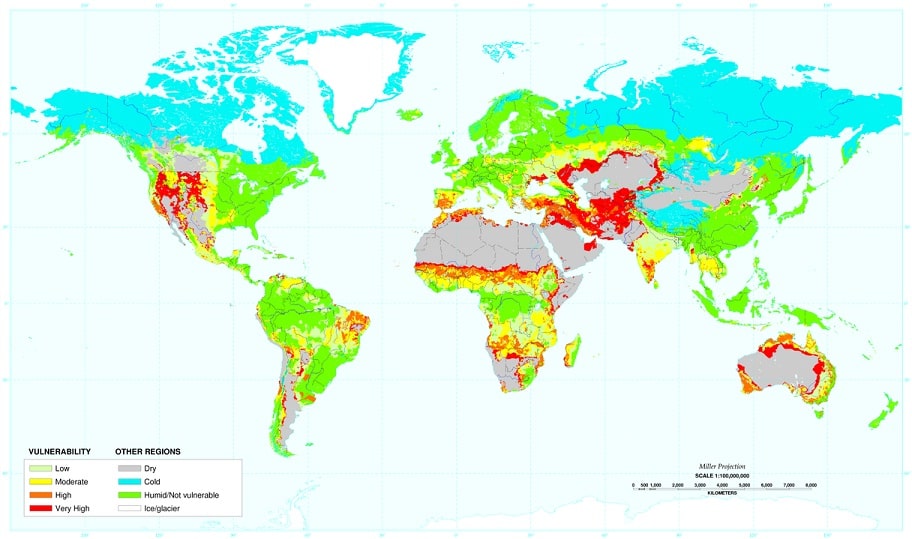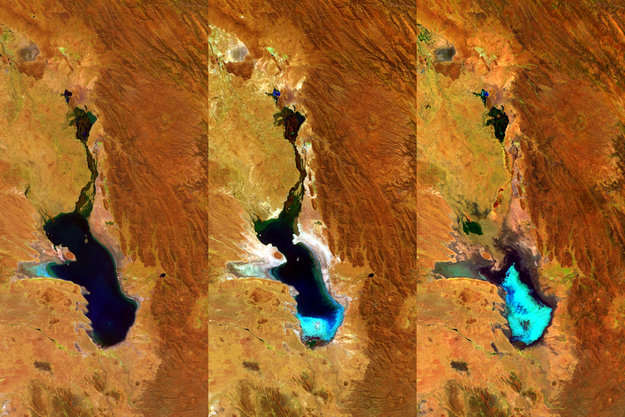According to the UN data, arid lands already occupy 41% of the earth’s landmass and serve as a habitat for more than 2 billion people. Let’s get acquainted with the most significant current examples of desertification and вrought, collected by Rubryka.
According to the secretariat of the UN Convention to Combat Desertification, by 2030, 135 million people worldwide are likely to be forced to migrate due to environmental degradation of their lands.
Every minute the world degrades 10 hectares of soil, deserts 23 hectares of land, carbon emissions increase by 6150 tons.
We answer why this happens and what are the consequences of this inconspicuous process for human eyes.

Consequences of desertification
Why is desertification spreading around the world, and what is it threatening?
Deforestation
When trees and other vegetation in the area disappear, there are no roots to hold the soil in place, no canopy to protect the ground from direct rain or solar heat. The bare soil then dries more efficiently and turns into dust, which can be blown up and washed away in one storm.
As soon as the soil degrades and valuable nutrients are lost, only barren and sluggish plots of land remain. Without trees, even the local climate becomes drier due to the lack of total evaporation of water from the tree canopy, which reduces the formation of clouds in the region and reduces rainfall.
Moreover, deforestation often destroys the entire ecosystem of the area.
Overgrazing
Excessive grazing and desertification have always been closely linked. In arid regions, grass and other small vegetation are needed to keep the soil in place to prevent erosion and further soil damage. However, the paradox of life is that, especially in these vulnerable regions, livestock is often the only source of livelihood, and there are no restrictions that would regulate the maximum number of animals for a given place.
When people gather and keep too many animals in one area, the grasses begin to die because their roots are often weakened by animals that constantly step on them and uproot them before the plants have time to grow, become resilient, and multiply.
After some time, no vegetation remains to prevent blowing or leaching of the soil. Thus, people move cattle to another piece of land, where the process is repeated. And this leads to large-scale desertification.
Unstable methods of agriculture
The world’s arid lands cover about 40% of the total land area. They are home to more than 2 billion people, so it is clear that many of these areas are farmed, although they are very fragile and can quickly become barren.
By reckless farming methods, such as heavy tillage, planting unsuitable crops, and leaving grants open to wind and rain erosion, farmers are only accelerating the process of desertification in exchange for low-quality crops with low economic value. In addition, when preparing the soil for sowing, natural vegetation is removed, which keeps the fragile soil in place, allowing the last parts of the productive layer of soil to be ultimately “erased” in just a few short seasons.
Another common problem is the use of improper irrigation methods, such as irrigation of canals. These watering methods often lead to the accumulation of salt in the soil. Increased salinity is since irrigation water mobilizes natural salt in these soils. In addition, artificially added water also rises; otherwise, the groundwater level becomes low, which, in turn, dissolves even more salts. Thus, the accumulation of salt on arable land complicates the cultivation of crops and other plants and further exacerbates the degradation of these lands.
Lack of moisture
Arid lands, most prone to desertification, are characterized by water shortages at certain times of the year. This means that the original ecosystem of these lands is well adapted to withstand the dry seasons during which plants enter the so-called summer dormancy, a temporary cessation of growth to preserve themselves, only to become green and strong as soon as the rains begin.
The problem arises when a person tries to change these natural cycles and tries to create conditions for stable crop production or sufficient cattle grazing on these lands throughout the year. In such circumstances, people often use water from available resources (streams, rivers, or even groundwater) to irrigate crops.
Lack of water to support agriculture and desert sands is already creating problems for rice farmers in all parts of northern China. Local agronomists confirm that excessive water extraction has led to the creation of rice fields, which has accelerated the current expansion of the desert.
Climate change
Rising temperatures or decreasing rainfall lead to the drying of lands. Global warming is by no means a myth, in Many people have already been able to see this.
It is important to realize one thing if we want to understand how climate change is causing desertification. By removing natural vegetation from landscapes, we are radically changing the water absorption capacity of soils. With less permanent vegetation that helps retain moisture in the soil and less moisture that evaporates from the plants into the air, fewer clouds are formed in this particular area. It also means less rain during the year.
With a significant reduction in rainfall, there is a drought and problems such as crop failure, a drought of streams and wells, poor pasture that weakens livestock, and more frequent outbreaks of forest fires that destroy the remaining plant.
Biological death
Infection of soil and plants with toxic and poisonous substances leads to the death of flora and living organisms in the soil.
This leads to severe depletion of the soil and its desertification.
Hunger, poverty, and political instability
Although desertification indeed leads to these problems, they can also be the cause. This is because people who are on the brink of starvation, extreme poverty, or political instability in their country need to resolve the crisis now and do not have time to think about sustainable cultivation strategies.
Unfortunately, their forced livelihoods often result in poor land-use practices, such as grazing on eroded lands, illegal deforestation, and unsustainable crop cultivation, which only contribute to soil destruction and further endanger human life.
World examples

Lake Poopo, Bolivia
Poopo was a salt lake on the Pune Plateau in western Bolivia, in the Andes, at an altitude of 3690 m. The second-largest lake in Bolivia after Titicaca, the resting place of many migratory birds, including flamingos.
The disappearance of the saltwater body was recorded by the ESA proba-V mini-satellite, which monitors the earth’s surface.
Its gradual disappearance is reflected in a series of satellite images taken in April 2014, July 2015, and January 2016.
Poopo

Bolivia’s second-largest lake completely evaporated in 2016
Previously, the lake area was 3 thousand square kilometers, and the depth was only from one and a half to four meters.
The shallow depth of the reservoir, as well as its location in arid areas, have made Poopo vulnerable to climate change. This is not the first time the lake has evaporated: a similar case was recorded in 1994.
At the same time, experts fear that this time the restoration of Poopo may take years, and it may disappear forever. Experts attribute the disaster to environmental changes and waste from the local mining industry, as well as to climate change and the El Niño phenomenon, which has led to a drought in the region.
The lake was declared a disaster zone by the Bolivian authorities in December 2015.

Gobi Desert, Mongolia
Scientists have proven that overgrazing is the main reason that about 70% of the once rich pastures of the Mongolian steppes are now slowly taking over the Gobi Desert.
The situation in Mongolia is alarming, mainly because this land degradation has occurred only recently. It began to take shape in the 1990s when job shortages due to the collapse of the Soviet Union forced people to engage in animal husbandry as the only way to earn money.

The Aral Sea, the border of Kazakhstan and Uzbekistan
The drying up of the Aral Sea is a sad example of the destructive power of poor agriculture. The Aral Sea was the fourth-largest salt lake in the world until the 1960s when the Soviet government diverted the Amu Darya and Syr Darya rivers, which filled the lake with fresh water.
This was done through ambitious projects to grow cotton in the dry basin of the Aral Sea, which needed irrigation. Cotton in the desert, combined with poorly constructed irrigation canals, from which a lot of water simply evaporated, reduced the size of the Aral Sea by 90% (!). And the land of the dry lake basin has turned into a saline desert, where nothing grows by itself.
Local communities that once lived near a lake rich in fish and biodiversity now live only amid dust, pesticide pollution, and scorching heat. They are the ones who see the ugly face of desertification.

Brazil
Today, desertification and soil degradation have affected 11 of Brazil’s 27 federal districts, amounting to about 1.35 million square kilometers.The puddle is all that is left in one of the reservoirs of the Cantareira system, which usually supplies almost half of the capital’s region of Sao Paulo.



